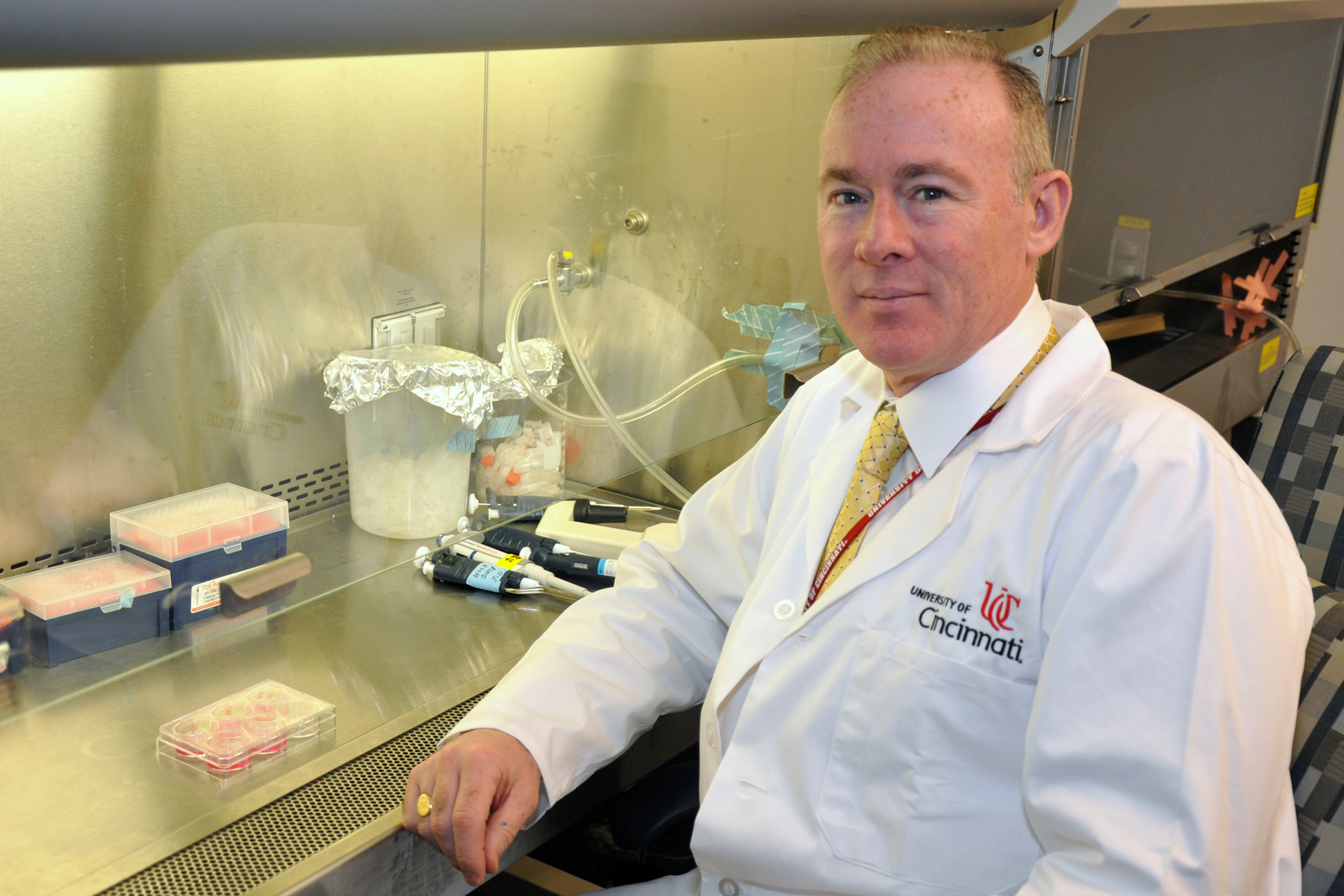UC Brain Tumor Center tests thousands of compounds in search of new glioblastoma treatment
The laboratory of James Driscoll, MD, PhD, at the University of Cincinnati Brain Tumor Center is throwing almost everything but the kitchen sink at an aggressive type of brain tumor that has proved stubbornly resistant to conventional forms of treatment. In a novel, investigator-initiated study, Dr. Driscoll and his team are testing over 2,000 different small-molecule compounds for signs of effectiveness in the treatment of the high-grade glioma tumor known as glioblastoma multiforme.

James Driscoll, MD, PhD
The research holds promise for individuals who develop glioblastoma multiforme, a malignant brain tumor diagnosed in approximately 10,000 people annually in the United States. Glioblastoma presents special problems for doctors because it is not solid and cannot be removed in one clean piece. The tumor is diffuse and infiltrative, and individual cells tend to survive surgery, radiation and traditional chemotherapy. As a result, the tumor often grows back near the site of the initial mass.
Moving rapidly, they have developed a high-throughput, automated screen to rapidly test hundreds of compounds at the same time. And although not yet prepared to discuss the results, Dr. Driscoll says he hopes to be able to pursue funding for a Phase I clinical trial involving one or more of the compounds within the next 12 months. The trial would take place at the Brain Tumor Center, a center of excellence within the UC Neuroscience Institute and the UC Cancer Institute. Both institutes are part of the UC College of Medicine and UC Health. The current laboratory study was funded in October by a $50,000 grant from the Mayfield Education & Research Foundation's Precision Radiotherapy Center Fund, which is supported by physicians of the Mayfield Clinic and University Radiation Oncology.
"Glioblastoma takes a heartbreaking toll on families and patients," says Dr. Driscoll, Assistant Professor in the Division of Hematology-Oncology at UC. Specifically, Dr. Driscoll and his team are targeting mutations in the epidermal growth factor receptor (EGFR), a protein on the surface of cells whose malfunction in several types of cancers has been discovered only in the last few years. Mutations or amplification of EGFR can lead to faulty signaling or "overactivation," which causes cells to multiply too rapidly and to result in cancer. At least 30 to 50 percent of glioblastoma cases involve a malfunction of the EGFR receptor.
Ronald Warnick, MD, Medical Director of the UC Brain Tumor Center and a co-investigator in the study, has likened EGFR overexpression to a "switch that has been set permanently in the 'on' position." A medication that could turn off the switch, he says, "could potentially suppress or inhibit the tumor's rapid, uncontrolled growth."
Unlike other types of cancer that involve EGFR, however, recent evidence has shown that glioblastoma tumors are heterogeneous and can reflect two different types of EGFR malfunction: 1) an EGFR wild-type that is overexpressed; and 2) a specific mutation called EGFRvIII. "That's good in the sense that it presents us with a new target," Dr. Driscoll says. "But it's also bad in that this target will require a unique treatment. Generally, specific forms of targeted therapies against the wild-type form are not effective against EGFRvIII and vice versa." Making things more complicated, both the wild-type and EGFRvIII forms can co-exist in a single patient, making therapies that target only one form deficient.
To accomplish the massive and rapid screen, called a "high-throughput screen," Dr. Driscoll and his team have developed an automated plate-reader-based screen to identify compounds that kill brain tumor cells that are genetically identical except for expression of different versions of EGFR: namely the wild-type form, the EGFRvIII variant, and a kinase-inactive form of EGFR that does not modify other proteins.
Dr. Driscoll and his team are looking for small molecules that kill all three or that are best at killing just one of the brain tumor cell types. "Our dream is to find something that kills both the EGFR wild-type and the EGFRvIII," Dr. Driscoll says.
The compounds have been drawn from pharmacological "libraries" of small molecules. Some are already FDA-approved, while others are in preclinical stages within the pharmacological industry.
Once the initial screening is complete, the Driscoll lab will refine its results. The third step, Dr. Driscoll says, will involve seeking national or pharmaceutical-based funding for a Phase I clinical trial.
Dr. Driscoll was recruited to UC in 2011 by George Atweh, MD, Director of the Division of Hematology-Oncology and Director of the UC Cancer Institute. Although Dr. Driscoll's primary focus is cancers of the blood (myeloma, lymphoma and leukemia), he is also drawn to the challenges posed by high-grade gliomas, tumors he describes as daunting. "One of the attractive features of this area of research is that any insights could be valuable," he says.
His laboratory includes research associates Sajjeev Jagannathan and Arasakumar Subramani and collaborates extensively with Atsuo Sasaki, PhD, Assistant Professor in the Division of Hematology-Oncology.
For immediate release:
January 15, 2013
For more information contact:
Deborah Livingston
Development Director
Mayfield Education & Research Foundation
(513) 569-5277
dlivingston@mayfieldfoundation.org